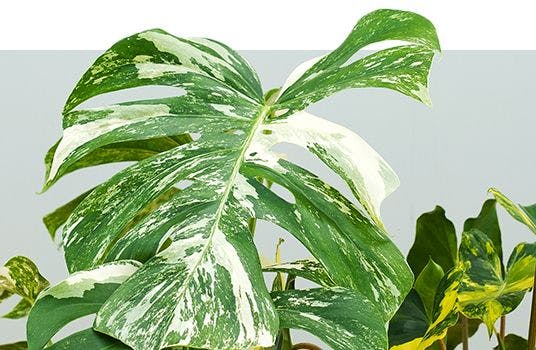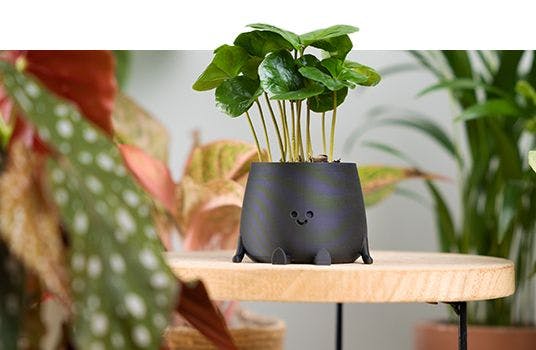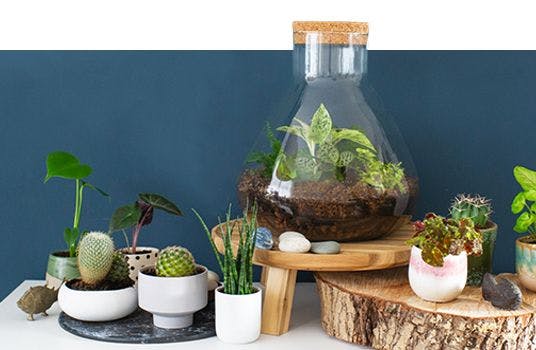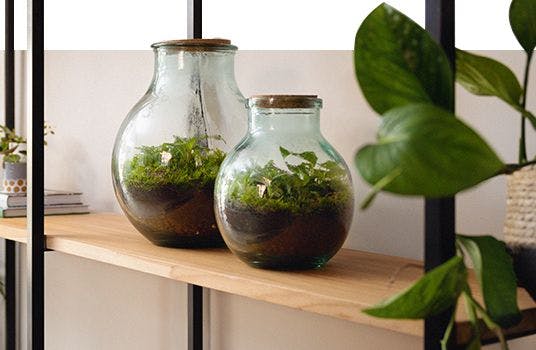
Fertilizers, which ones are there and what do I need to know?
The growing season is in full motion, which gives us lots of new growth to enjoy! We are busy with propagating cuttings and probably have adjusted the way we care for plants to the season. What also peeks around the corner, is fertilizing your houseplants. Adding fertilizers to our plants brings many benefits since we provide some extra energy to our plants in order for them to grow strong and healthy. This is exactly where the questions pop up. Which type of fertilizers are there and which one is the best? In this blog, we will take a deep dive into two types of fertilizers: liquid and slow-release fertilizers. Let’s get into it!
Types of houseplant fertilizers
Liquid fertilizers
Liquid fertilizers are most commonly used. These are the types of fertilizers that are mixed with water and given to our plants when we water them. This makes fertilizing our house plants rather easy, but we do have to remind ourselves on a frequent basis to add this liquid into our watering can. Every type of fertilizer has its pros and cons, so let’s see what liquid fertilizers have to offer us and where they shoot short in some departments.
Pros of using liquid fertilizers:
- They are easy to use
- When given the plant can absorb the nutrients directly
- The fertilizer will be evenly distributed throughout the water, covering the soil evenly.
- They can be used directly on the soil, or can be added to a spray for foliar feeding*
Cons of using liquid fertilizers:
- Liquid fertilizer washes out of the soil, which makes it not last for long
- It can be more expensive

The best liquid nutrition for houseplants
If you ask us, our PLNTS nutrition is the best liquid fertilizer for houseplants. We have created a liquid nutrition, in cooperation with some real plant experts in order to give you a product that will fuel your plants. With fertilizers, there are main components and micronutrients. These main components are Nitrogen (N), Phosphorus (P₂O₅), and Potassium (K₂O) (N-P-K-). We made this fertilizer strong, but not too strong. If you want to know more about our PLNTS nutrition and its ingredients, make sure to check our nutrition page.
When you add too much fertilizer to your soil, you may cause a chemical burn in your root system. This is what we call root burn and will explain more about this later on in this blog.
Keep in mind that adding too much fertilizer can burn your roots, even if you use our perfectly blended liquid fertilizer. Our nutrition is almost 100% organic since we try our absolute best to provide you with environmentally conscious products. The nutrition goes a long way, 8 millilitres of nutrition can be mixed with 1 liter of water. Simply water your plants with this cocktail, as you would normally. Generally, plants need this once a month, but some plant families like more nutrition and others less. That is why you should always look at what your specific plant needs and thrives from. You can find all the additional care information per plant family on our PLNTS doctor page.
* What is foliar feeding?
Plants have the tiniest holes within their foliage, called the Stomata. These are not visible with the bare eye but do a lot for the plant. These little holes are able to absorb, but also are used by the plant to release substances. When you want to make use of this ability, you could try foliar feeding. This may sound fancy, but is actually quite easy! This is when you add your liquid fertilizer to your spray bottle and mist your plants with this instead of regular water. This way your plants can absorb the nutrients from the stomata. Although the 3 main nutrients are not absorbed as easily through the Stomata as through the roots. That is why we would not necessarily recommend this way of fertilizing your houseplants.

Slow-release fertilizer
Slow-release fertilizers are fertilizers in the form of granules that you have to mix into the soil of your plants. The exact amount will be on the instructions from your specific product. Once they are mixed in the soil, they work smart by releasing more nutrients in warmer weather and less in colder weather. This is exactly what your plants need. They have their pros and cons.
Pros of using slow-release fertilizers:
- Last for a long time and don’t need to be applied frequently
- Can be cheaper than liquid fertilisers
Cons of using slow-release fertilizers:
- Harder to apply
- Take longer to be absorbed by the plants

The best slow-release fertilizer for houseplants
If you ask us, our PLNTS Osmocote granules are the best slow-release fertilizer for houseplants. The PLNTS Osmocote granules can be mixed in with the soil. The amount of granules needed is 3-4 grams per litre of potting soil. Once mixed, plant your plant in the soil as you would with regular soil. Now your plant has nutrients that will last 8-9 months! These granules are smart and will release more nutrition with warmer weather, which is when your plant will grow quicker and need the nutrients. With colder temperatures the granules will do the opposite, now your plant has what it needs and you don’t have to think about it for the coming months.
What is salt build-up?
Salt build-up is a term you may encounter when thinking of fertilizing your plants. Salt build-up occurs when minerals and salts can build up in the soil, due to over fertilization or by giving hard water to your houseplants. You would usually see a crystalized white coating on the leaves. You can also see a white crust forming on the soil or substrate the plant is growing in.
A plant that has salt buildup might have the following symptoms:
- Yellow or brown leaves
- Drooping of wilting leaves
- A white crusty layer on the soil

How do you prevent salt build-up?
You should try to avoid salt build-ups at all times because it can cause your plant to die! You can prevent salt build-ups, by watering your plant from the top and draining the excess water. For example, by using well-draining soil and a pot with drainage holes. This way, the minerals and salt can flush from the soil, instead of sitting tidy in the soil.
How do you fix salt build-up?
When your plant is suffering from salt build-up, there are a few things you can do for your green friend.
- You can try to give your plant less harsh water, like distilled water. This type of water does not contain salts or minerals, which prevents you from building them in the soil.
- Another way is to not solely bottom water your plant, as salts and minerals flush from the soil when you water them from the top and let the excess water drain. This is a great way to get rid of the salt build-up in your soil.
- Repot your plant and provide fresh soil. This soil won’t contain built-up salts and minerals, which gives your plant a fresh start. This is only needed in severe cases. Or when you rather get rid of the salt build-up at once.
- If your pot has a white crust forming on it, try to wash it or replace the pot.
What is root burn?
Another term you may come across when researching plant nutrition is root burn. Root burn can occur when you over-fertilize your houseplants. This can happen with all forms of fertilizers. Different plants have different needs when it comes to fertilizers, which is what you should always take into consideration before giving your plant any type of nutrition. The amount also highly depends on the brand of fertilizer and how concentrated the product is.
Root burn causes the following symptoms:
- Impaired growth
- Brown leaf edges and tips
- Leaf scorching
- Leaf curling
- Roots discoloration (brown and black)
- Leaves falling off

So what is the best fertilizer for houseplants?
The truth is that both liquid and slow-release fertilizers are equally as good. It really depends on what you prefer to use. Don’t you mind reminding yourself to mix in liquid fertilizer on a frequent basis? Perfect, that is what you need. Would you rather get your hands dirty, mix in the slow-release granules, and not have to remind yourself about fertilizing your houseplants for several months? Then this is the fertiliser for you. They do the exact same thing but in different manners.
We hope this blog was helpful to you and that you can get going with fertilizing your houseplants!

Carlijn is probably one of the biggest plant geeks ever. She is always on the lookout for new gems and loves to share all her plant knowledge, tips and inspiration with our community!
More about Tips
Free shipping from €75,-
We ship our plants all over Europe!
30 day health guarantee
For all our happy plants. Read more about our guarantees.
- Delivery throughout Europe
- Free shipping for orders over €75,-
- 30 day PLNTS health guarantee









